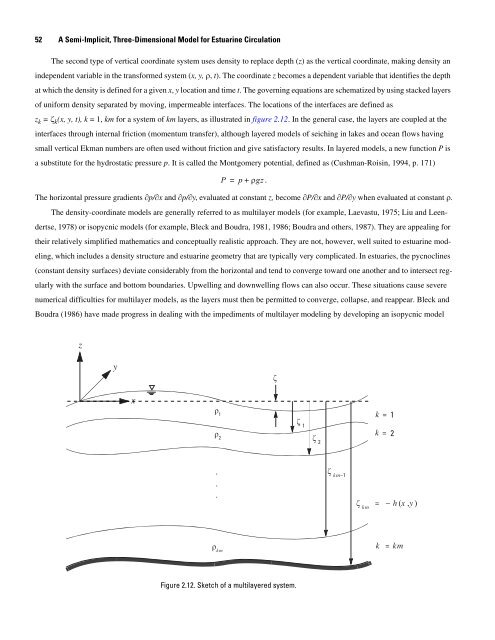A Semi-Implicit, Three-Dimensional Model for Estuarine ... - USGS
A Semi-Implicit, Three-Dimensional Model for Estuarine ... - USGS
A Semi-Implicit, Three-Dimensional Model for Estuarine ... - USGS
Create successful ePaper yourself
Turn your PDF publications into a flip-book with our unique Google optimized e-Paper software.
52 A <strong>Semi</strong>-<strong>Implicit</strong>, <strong>Three</strong>-<strong>Dimensional</strong> <strong>Model</strong> <strong>for</strong> <strong>Estuarine</strong> Circulation<br />
The second type of vertical coordinate system uses density to replace depth (z) as the vertical coordinate, making density an<br />
independent variable in the trans<strong>for</strong>med system (x, y, ρ, t). The coordinate z becomes a dependent variable that identifies the depth<br />
at which the density is defined <strong>for</strong> a given x, y location and time t. The governing equations are schematized by using stacked layers<br />
of uni<strong>for</strong>m density separated by moving, impermeable interfaces. The locations of the interfaces are defined as<br />
z k = ζ k (x, y, t), k = 1, km <strong>for</strong> a system of km layers, as illustrated in figure 2.12. In the general case, the layers are coupled at the<br />
interfaces through internal friction (momentum transfer), although layered models of seiching in lakes and ocean flows having<br />
small vertical Ekman numbers are often used without friction and give satisfactory results. In layered models, a new function P is<br />
a substitute <strong>for</strong> the hydrostatic pressure p. It is called the Montgomery potential, defined as (Cushman-Roisin, 1994, p. 171)<br />
P = p+ ρgz .<br />
The horizontal pressure gradients ∂p/∂x and ∂p/∂y, evaluated at constant z, become ∂P/∂x and ∂P/∂y when evaluated at constant ρ.<br />
The density-coordinate models are generally referred to as multilayer models (<strong>for</strong> example, Laevastu, 1975; Liu and Leen-<br />
dertse, 1978) or isopycnic models (<strong>for</strong> example, Bleck and Boudra, 1981, 1986; Boudra and others, 1987). They are appealing <strong>for</strong><br />
their relatively simplified mathematics and conceptually realistic approach. They are not, however, well suited to estuarine mod-<br />
eling, which includes a density structure and estuarine geometry that are typically very complicated. In estuaries, the pycnoclines<br />
(constant density surfaces) deviate considerably from the horizontal and tend to converge toward one another and to intersect reg-<br />
ularly with the surface and bottom boundaries. Upwelling and downwelling flows can also occur. These situations cause severe<br />
numerical difficulties <strong>for</strong> multilayer models, as the layers must then be permitted to converge, collapse, and reappear. Bleck and<br />
Boudra (1986) have made progress in dealing with the impediments of multilayer modeling by developing an isopycnic model<br />
z<br />
y<br />
x<br />
ρ 1<br />
ρ 2<br />
.<br />
.<br />
.<br />
ρ km<br />
Figure 2.12. Sketch of a multilayered system.<br />
ζ<br />
ζ 1<br />
ζ 2<br />
ζ km–1<br />
ζ km<br />
k = 1<br />
k = 2<br />
=<br />
–<br />
k = km<br />
h ( x , y )

















